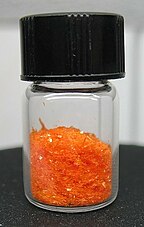Eugène-Melchior Péligot (24 March 1811 – 15 April 1890), also known as Eugène Péligot, was a French chemist who isolated the first sample of uranium metal in 1841.[2]
Eugène-Melchior Péligot | |
|---|---|
 | |
| Born | 24 March 1811 |
| Died | 15 April 1890 (aged 79) |
| Nationality | French |
| Known for | Discovery of Potassium chlorochromate |
| Awards | Legion of Honor[1] |
| Scientific career | |
| Fields | Chemistry |
| Institutions | Institut National Agronomique |
Péligot proved that the black powder of Martin Heinrich Klaproth was not a pure metal (it was an oxide of uranium, known in chemistry as UO2). He then succeeded in producing pure uranium metal by reducing uranium tetrachloride (UCl4) with potassium metal.[3] Today better methods have been found.[4]

Péligot was a professor of analytical chemistry at the Institut National Agronomique. He collaborated with Jean-Baptiste Dumas, and together they discovered the methyl radical during experiments on wood spirit (methanol). The terminology "methyl alcohol" was created by both chemists from "wood wine". They also prepared the gaseous dimethyl ether, and many esters. In 1838, they successfully transformed camphor into p-cymene using phosphorus pentoxide.
In 1844 he synthesized chromium(II) acetate,[5][6] which was much later recognized (by F. Albert Cotton in 1964) to be the first chemical compound which contains a quadruple bond.[7]
See also
editReferences
edit- ^ Eugène Péligot, membre de l'Institut
- ^ "Uranium | Radiation Protection Program | US EPA". www.epa.gov. Archived from the original on 2008-01-17.
- ^ Celestial Bodies Archived 2002-02-20 at the Wayback Machine
- ^ Chisholm, Hugh, ed. (1911). . Encyclopædia Britannica. Vol. 27 (11th ed.). Cambridge University Press. p. 788.
- ^ Peligot, E.-M. (1844). "Sur un nouvel oxide de chrome". C. R. Acad. Sci. (in French). 19: 609–618.
- ^ Peligot, E.-M. (1844). Ann. Chim. Phys. (in French). 12: 528.
{{cite journal}}: Missing or empty|title=(help) - ^ Cotton, F. A.; Walton, R. A. "Multiple Bonds Between Metal Atoms" Oxford (Oxford): 1993. ISBN 0-19-855649-7.
External links
edit